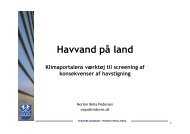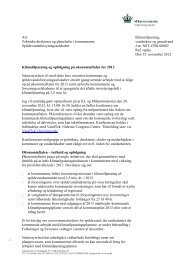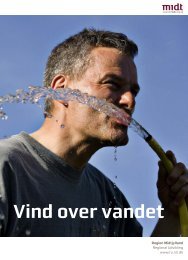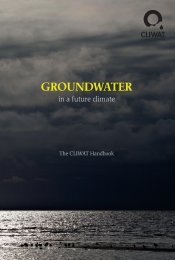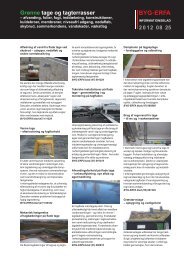Mapping climate change - barriers and opportunities for action
Mapping climate change - barriers and opportunities for action
Mapping climate change - barriers and opportunities for action
Create successful ePaper yourself
Turn your PDF publications into a flip-book with our unique Google optimized e-Paper software.
Possibilities <strong>for</strong> adaptation<br />
Traditionally, the immediate response to managing extreme rainfall has been to install larger sewer<br />
pipes <strong>and</strong> to build retention basins, or to manage surface water locally. In many situations, an<br />
expansion of the existing drainage systems could take place in connection with ongoing renovation<br />
work. Locally, it will be possible to <strong>climate</strong>-proof against water damming up e.g. in critically sited<br />
basements, or initiatives could be launched to divert the water to where it does least damage. In<br />
practice, an expansion of the sewer system will not always be the most socio-economically<br />
appropriate solution.<br />
Today, some municipalities already partially compensate property owners <strong>for</strong> the connection charge<br />
(a lump sum) if the owner installs a dry well on his ground to divert rainwater, or another local<br />
rainwater bypass solution. The Danish Nature Agency has analysed the different models that can<br />
provide incentive to reduce the drainage of rainwater into the central sewers. The opportunity <strong>for</strong><br />
establishing local infiltration solutions depends on e.g. local soil conditions, <strong>and</strong> this option is<br />
there<strong>for</strong>e not present on all locations. Another solution could be to retain <strong>and</strong> store the rainwater in<br />
basins on the individual property. However, this type of solution may be associated with large costs<br />
<strong>for</strong> the individual property owner.<br />
Initiatives completed <strong>and</strong> in progress<br />
Strategic <strong>climate</strong> <strong>change</strong> adaptation in Greve Municipality<br />
Due to a greater number of intense flooding events, Greve Municipality has decided the city's surface<br />
<strong>and</strong> wastewater management system is to be able to cope with 30% more water. The required adaptation<br />
of the system is being carried out at a total of 42 urban districts addressing the most critical areas first.<br />
This <strong>climate</strong> <strong>change</strong> adaptation initiative includes both existing <strong>and</strong> future run-off <strong>and</strong> drainage<br />
systems, <strong>and</strong> the entire surface water management system <strong>and</strong> local watercourses are being included in<br />
the scale-up, which is expected to be completed by 2020. The adaptation initiative is being implemented<br />
using a strategy model that is based on a combined l<strong>and</strong>scape <strong>and</strong> surroundings model, as well as a<br />
hydraulic model, which calculates how water flows in the drainage systems <strong>and</strong> in watercourses.<br />
The municipality has also been working on emergency response plans to ensure the municipality will be<br />
able to execute a timely response in the event of extreme rainfall <strong>and</strong>/or elevated water levels, thus<br />
reducing the extent of damage.<br />
With the enhanced capacity of watercourses <strong>and</strong> surface water <strong>and</strong> drainage systems, <strong>and</strong> the<br />
emergency response planning, the municipality is expected to be able to prevent more negative impacts<br />
from extreme rainfall in future.<br />
Key stakeholders have identified a number of legislative obstacles <strong>for</strong> financing <strong>and</strong> incorporating<br />
<strong>climate</strong> <strong>change</strong> adaptation ef<strong>for</strong>ts in surface water <strong>and</strong> wastewater planning. A process has there<strong>for</strong>e<br />
been initiated in order to solve the current problems <strong>and</strong> to ensure the proper legislative framework<br />
is in place <strong>for</strong> carrying out the socio-economically best solutions.<br />
The Danish Water Sector Re<strong>for</strong>m Act introduced a price cap which entails that additional expenses<br />
may only be added to charges under special circumstances, e.g. operational expenses <strong>for</strong><br />
environmental <strong>and</strong> service goals. Regulation in the area is however unclear <strong>and</strong> this has kept many<br />
of the water utility companies from seeking approval of a supplement to the price cap.<br />
45







